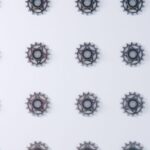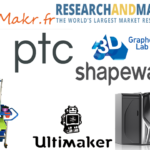

Advances in 3D printing aren’t only occurring in the technology of the machines or in the materials that can be used for printing, but also in the very creation of the materials themselves. As 3D printers become a prominent method for the creation of manufacturing components, the need for the production of stronger and more stress-resistant parts calls for the creation of new materials. And with global revenues of US $2.2 billion generated through additive manufacturing techniques, you can bet that this has the attention of a large number of researchers around the world.
At the University of Lorraine in France, researchers have developed a metal alloy with properties that are crystal-like in nature. This type of Complex Metal Alloy (CMA) is known as a quasicrystal and forms an integral component in the design and creation of new materials for 3D printing. CMA materials are of particular interest because of properties such as high resistance to wear and corrosion as well as low friction. The need to develop new CMA materials comes from the inherently brittle nature of the currently existing CMAs, something that prevents their implementation on a large enough scale to be useful to large manufacturers.

It is through the incorporation of this new CMA into a composite material, that addresses its inherent weaknesses while bringing its strengths into play, that may make this shift in scale possible. The composite material that has been developed for use in 3D printing to date, has mechanical properties similar to those present in composites of brass and steel, but provide the advantage of having a significantly lower density.
The research and its conclusions performed by Samuel Kenzari, David Bonina, Jean Marie Dubois and Vincent Fournée of the University of Lorraine, has been published in a paper titled “Complex Metallic Alloys as New Materials for Additive Manufacturing” and was published in the Journal of Science and Technology of Advanced Materials. The polymer matrix composites currently in use in 3D printing have been successfully reinforced with quasicrystals, according to the research team.
The success has been such that commercialization of the material is already underway. Researcher Vincent Fournée noted that there has been particular interest from the aeronautics and automobile industries as the reduction in density leads to a reduction in the overall weight of the vehicle. This lowered weight increases fuel efficiency, something which he says has great appeal to those sectors.
The next frontier for the application of this new material is in the area of health, and the researchers have already begun a series of new investigations that will lead in that direction. What do you think of this new material? Discuss in the Adding Quasicrystals to Complex Metal Alloys forum thread on 3DPB.com.
If you're looking to get architectural 3D animation in the USA, our service provides an exceptional way to bring your architectural concepts to life through dynamic, immersive visuals. Through our platform, you can easily request high-quality 3D animations that showcase your designs in motion, offering a detailed view of your project from multiple angles and perspectives. Whether it's for a real estate development, a commercial building, or an urban planning project, our expert team ensures that every detail is captured in a visually compelling animation.
Through our website, you can seamlessly get architectural 3D animation tailored to your project’s specific needs. With our help, you can offer potential clients or investors an engaging experience that goes beyond static images. By integrating CGI animations with real-world settings, lighting, and textures, our team creates a lifelike experience that allows your audience to interact with your project as though it were already built. This service is perfect for presenting complex designs in a clear, visually attractive way that stands out in the competitive architectural market.




